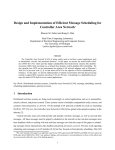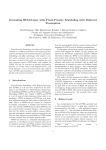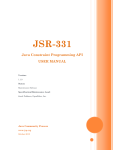Download FPSCALC Version 2.00 User's Manual
Transcript
Uppsala University
Department of Computer Systems
FPSCALC
Version 2.00
User's Manual
Harmen van der Velde
January 30, 1997
Technical Report nr. DoCS 97/89
Abstract
This document describes the FPSCALC program, a program that is used
to perform schedulability tests on task sets for real-time operating systems implementing xed priority scheduling. It was written in the light of
research done on Real-Time CAN-bus driven environments.
1 Introduction
When performing real-time systems xed priority scheduling [Tin95] we need to
do a lot of mathematical calculations to determine if our task sets are schedulable. For instance, if we take a task set like this1 :
Task Name
A
B
C
D
E
F
G
H
T
250
500
800
800
1000
2000
2000
2000
C
14
50
90
20
50
10
10
30
D
50
200
400
800
1000
2000
2000
2000
P
1
2
3
4
5
6
7
8
Table 1: An example task set
This example has priorities assigned according to deadline monotonic priority ordering (earliest deadline has the highest priority). We use the following
formula to determine the response time of a task i:
Ri
= Ci +
X
8j 2hp(i)
&
Ri
'
Tj
Cj
The results for the consecutive iterations n are denoted as Rin . The initial
values are Ri0 = 0.
For example, we can now calculate the value of RC :
1
RC
= CC + 0 = 90
We iterate the solution a second time:
90 C + 90 C = 154
2
RC = CC +
A
B
T
T
A
And again:
B
154
154
CA +
CB = 154
RC = CC +
TA
TB
3
The iteration has now ended since RC2 = RC3 , so we can say that RC = 154.
We can also now say that RC is schedulable, for RC < DC . To make sure the
whole task set is schedulable, we will have to repeat this calculation for every
single task. It is obvious that this involves a lot of manual calculation, which
is rather mechanical. In fact, it is so mechanical that this job can easily done
by a computer. Therefore, the FPSCALC program has been developed.
1
A higher priority is represented by a lower number.
2 Functional Description of the FPSCALC Program
The FPSCALC program takes input from a user specied le, which should be
organised as follows:
One or more task sets.
Each task set's relevant variables and (optional) their initial values.
Each task set's set of formulas to be used for calculation.
Optionally, extra data concerning semaphores, used to calculate the blocking factors for each task set.
2.1 Description of the Input File Grammar
The input le can describe one or more systems. Each system is represented by
a set of variables and the formulae that compute these variables.
The input le is a text le that should should conform to the following grammar
given in appendix A.
System names, variable names, semaphore names and task names do not conict with each other. However the names should be anything other than the
reserved words, including the two reserved indices: i and j. The former is reserved to indicate the main index while the latter indicates the secondary index.
When used in a formula, the main index species that the calculation should
be performed for each task of the task set. The secondary index j is used inside
a summation only, indexing tasks of the task set according to the used priority
scheme. This will be explained in detail later on in this document.
The order in which the system blocks are placed is of no importance. Comments
are preceded by the `!' character. When this character is found on a line,
everything following it on this line will be ignored.
Within each system, the following blocks can be placed:
A declarations block.
A semaphores block.
An initialise block.
A formulas block.
How these blocks are declared, is described in the following sections.
2.1.1 The declarations Block
Within the declarations block, the following symbols can be declared:
Variables
Tasks
The variables can be any of four types:
Scalar
Indexed
Priority
Blocking
The scalar variables can hold only one value, where the indexed variables are
arrays. These arrays are indexed by the task names.
The user can only declare one priority variable as well as only one blocking
variable. Both variables are indexable.
The priority-type variable is reserved to indicate the priority of each task.
These priorities will be used inside of summation expressions, to be able to
distinguish between lower and higher priority task. Also, when calculating
blocking factors, the priorities are required. The priorities can be designated
manually in the desired order, but we can also set up a formula to calculate the
priorities dynamically.
The blocking-type variable represents the blocking factor of each task. If declared, the program will automatically calculate the blocking factor of each task
on initialisation. The introduction of blocking factors requires the declaration
of a semaphores block, which will be discussed later on. Of course, the user is
free to manually include blocking factors. The blocking factor variable should
then be declared as a common indexed-type variable, after which the user can
initialise the blocking factors manually, or set up a formula to calculate them
dynamically.
Together with the variables, the user can declare a set of task names. These
names can later be used to index the dierent members of the indexable variables. The order in which these task names are declared, is of no importance.
For instance, when sharing an indexed variable between two systems, no problems will occur when indexing task names have been declared in dierent orders
in these two systems. The program will match each index name automatically.
If the user neglects declaration of tasks, only the scalar variables can be used,
since the indexed variables would lack indices - the task names.
2.1.2 The semaphores Block
Some real-time systems use semaphores for managing shared resources. These
semaphores cause blocking factors [Tin95] that inuence the schedulability of a
task set. The blocking factor of each task is the maximum delay it might experience because of another task that has locked a certain resource by acquiring
the corresponding semaphore.
For example, a task set might have semaphores that are locked as displayed in
table 2.
Semaphore Locked by Time locked
S2
A
3
S4
G
3
S1
C
9
S2
E
13
S3
E
4
S3
F
4
S4
B
1
S5
G
7
S5
H
7
Table 2: Example semaphore declaration
Using this table, we can calculate the blocking factors with the following formula:
Bi =
max
(csk;s)
8k2lp(i)8s2uses(k)jceil(s)pri(i)
As mentioned in the previous section, blocking factors can be manually specied
by the user or automatically calculated by the tool. For automatic calculation,
we declare the semaphores in our input le, using the semaphore() command.
The rst argument of the semaphore() command species the name of the
semaphore, the second species the name of the task it is held by, and the third
and nal argument species the time it is held for.
In order to declare semaphores, the user must rst declare both a blockingtype variable and a priority-type variable. These two variables are essential
for calculation of the blocking factors. The program will then automatically
perform calculation of the blocking factors.
Last but not least, we must alter our formula for the response time to include
the blocking factors. For instance, we could add it to the formula we used in
our rst example. The scientic notation of it is:
Ri
= Bi + C i +
X
8j 2hp(i)
&
Ri
'
Tj
Cj
IMPORTANT NOTE!
When we use a formula to manipulate the task priorities dynamically, the blocking factors may change dynamically too. In case of
automatic blocking factors calculation, the program will automatically update these factors after each iteration if such a formula is
present.
2.1.3 The initialise Block
Before starting the calculation, all declared variables within a system can be
given initial values. This is done in the initialise block. In case of indexed
variables, each member of a variable can be given a value by indexing with
the desired task index. The value can be a constant value, or an arithmetical
expression.
Here are a few examples of initialisation:
ScalarVar = 5.0;
IndexVar[TaskIndexName] = -5/7 + 3.14159265;
AllMembersOne[i] = 1.0;
By indexing with the reserved index i, all members of an indexed variable will
be initialised with the same value.
Variables that aren't given an initial value, will be set to zero.
2.1.4 The formulas Block
Formulas are denoted in standard scientic notation. The types of the variables
left and right of the equal-sign should be the same, meaning that we cannot
compute an indexed expression and store it in a scalar, for instance.
Apart from the standard arithmetical operations `+', `,', `' and `=', identiers
have been reserved for the following mathematical operations:
sigma(hp, expression) - summation over higher priority tasks
For example, write sigma(hp, R[i] / T[j]) to calculate:
X
Ri
8j 2hp(i) Tj
The expression for summation is given between the parentheses. The
program will execute the summation for all tasks j with a higher priority
as the current task i.
sigma(lp, expression) - summation over lower priority tasks
For example, write sigma(lp, R[i] / T[j]) to calculate:
X
Ri
8j 2lp(i) Tj
The expression for summation is given between the parentheses. The
program will execute the summation for all tasks j with a lower priority
as the current task i.
sigma(ep, expression) - summation over equal priority tasks
For example, write sigma(ep, R[i] / T[j]) to calculate:
X
Ri
8j 2ep(i) Tj
The expression for summation is given between the parentheses. The
program will execute the summation for all tasks j with equal priority to
the current task i.
sigma(all, expression) - summation over all tasks
For example, write sigma(all, R[i] / T[j]) to calculate:
X
Ri
8j 2alltasks Tj
The expression for summation is given between the parentheses. The program will execute the summation for all tasks, regardless of their priority.
ceiling(expression) - the ceiling function
For example, write ceiling(R[i] / T[j]) to calculate:
&
Ri
'
Tj
This implements the ceiling operation, which returns the smallest integer
greater than or equal to its operator.
oor(expression) - the oor function
For example, write oor(R[i] / T[j]) to calculate:
$
Ri
%
Tj
This implements the oor operation, which returns the largest integer
smaller than or equal to its operator.
min(expression) - the min function
For example, write min(R[i], T[i]) to calculate:
min(Ri ; Ti )
This implements the min operation, which returns the smallest of its two
operands.
max(expression) - the max function
For example, write max(R[i], T[j]) to calculate:
max(Ri ; Ti )
This implements the max operation, which returns the greatest of its two
operands.
As you might have noticed, the formulas use two indexing parameters: i and j.
These parameters are used by the program to index the various task-parameters.
When the program starts, it will use i to address the current Ri being computed,
while it uses j to address the various task-parameters during a summation.
However, there is one special way in which a specic element of an indexed variable can be addressed. For instance, if we want to address variable Rtask name ,
we should use the following notation in our formula:
R[task name]
This method of indexing a variable is called direct indexing.
For each system, multiple formulas may be given the input le. When more
than one formula is given, the program will sequentially iterate through all of
them cyclically, until their results converge. This feature can be used to solve
the holistic scheduling problem [Tin95].
2.1.5 Global Variables
When performing holistic scheduling analysis, we need to specify the interaction
between the dierent components of a system. Since all variables within a
system are completely isolated from each other, the concept of global variables
has been dened. We can declare a certain variable globally, meaning that this
variable is visible to all systems.
The declaration of global variables is done before the rst system block. Global
variables can only be declared of type indexed or scalar. Initialisation can be
done within any system block. Note that a multiple initialisation will result
in initialisation of the variable, according to the last initialisation given in the
input le. Previous initialisation values will be overriden!
3 Running the Program
The syntax of the FPSCALC program is as follows:
fpscalc [-v] < input_file
The ag -v designates verbose mode. In this mode, the program will output the
parsed initial values of all the variables after initialisation. It will also output
the results of the calculations after each iteration. The program will read its
input le from standard input.
After a correct input le has been set up, the program can be run.
3.1 An Example
Let us take the before mentioned task set with semaphores added to the input
le and store it in a le named definition_file.fps. The input le will now
look something like this:
! definition_file.fps - an example task set.
! Global variable declarations
scalar GlobalVar;
system testing {
! First and only system
declarations {
! Variable declarations
indexed Period, Deadline, CompTime, RespTime;
blocking Blockvar;
priority Priovar;
! Task declarations
tasks A, B, C, D, E, F, G, H;
}
semaphores {
semaphore(S2,
semaphore(S4,
semaphore(S1,
semaphore(S2,
semaphore(S3,
semaphore(S3,
semaphore(S4,
semaphore(S5,
semaphore(S5,
}
initialise {
A,
G,
C,
E,
E,
F,
B,
G,
H,
3);
3);
9);
13);
4);
4);
1);
7);
7);
Period[A]
Period[B]
Period[C]
Period[D]
Period[E]
Period[F]
Period[G]
Period[H]
=
=
=
=
=
=
=
=
Deadline[A]
Deadline[B]
Deadline[C]
Deadline[D]
Deadline[E]
Deadline[F]
Deadline[G]
Deadline[H]
Priovar[A]
Priovar[B]
Priovar[C]
Priovar[D]
Priovar[E]
Priovar[F]
Priovar[G]
Priovar[H]
250;
500;
800;
800;
1000;
2000;
2000;
2000;
=
=
=
=
=
=
=
=
=
=
=
=
=
=
=
=
50;
200;
400;
800;
1000;
2000;
2000;
2000;
CompTime[A]
CompTime[B]
CompTime[C]
CompTime[D]
CompTime[E]
CompTime[F]
CompTime[G]
CompTime[H]
=
=
=
=
=
=
=
=
1;
2;
3;
4;
5;
6;
7;
8;
14;
50;
90;
20;
50;
10;
10;
30;
}
! Formula(s) to be iterated
formulas {
RespTime[i] =
CompTime[i] + Blockvar[i] +
sigma(hp, ceiling(RespTime[i] / Period[j]) * CompTime[j]);
GlobalVar = CompTime[A] + CompTime[B] * CompTime[C];
}
} ! End of definition file
The program can now be run, using the following command:
$> fpscalc < definition_file.fps -v
When in the verbose mode, the program will now output the following:
Number of systems: 1
Furthermore, the program will output the found variables and their initial values
as follows:
Variable `Period'
Period[A] = 250.000000
Period[B] = 500.000000
Period[C] = 800.000000
Period[D] = 800.000000
Period[E] = 1000.000000
Period[F] = 2000.000000
Period[G] = 2000.000000
Period[H] = 2000.000000
It will also output all the other variables it has found in exactly the same way
as the above but these are omitted in this text.
After the initialisation has completed, the program will calculate the blocking
factors and output the found values (when in verbose mode) as follows:
Variable `BlockVar'
Blockvar[A] = 13.000000
Blockvar[B] = 13.000000
Blockvar[C] = 13.000000
Blockvar[D] = 13.000000
Blockvar[E] = 4.000000
Blockvar[F] = 3.000000
Blockvar[G] = 7.000000
Blockvar[H] = 0.000000
It will also output the table of semaphores and their calculated ceilings as
follows:
Semaphores:
Name
S2
S2
S4
S4
Locked by
A
E
B
G
Time held
3.000000
13.000000
1.000000
3.000000
ceiling
1.000000
1.000000
2.000000
2.000000
S1
S3
S3
S5
S5
C
E
F
G
H
9.000000
4.000000
4.000000
7.000000
7.000000
3.000000
5.000000
5.000000
7.000000
7.000000
Now it has all the necessary data to start running the variables through the
given formula(s), iterating as many times as is necessary to converge to the
solutions. When in the verbose mode, it will output the value of the variables
after each iteration. After a short while it will display the nal values of the
variables as follows:
System `testing'
-----------------RespTime[A]
RespTime[B]
RespTime[C]
RespTime[D]
RespTime[E]
RespTime[F]
RespTime[G]
RespTime[H]
=
=
=
=
=
=
=
=
27.000000
77.000000
167.000000
187.000000
228.000000
237.000000
265.000000
288.000000
System `testing'
-----------------GlobalVar = 4514.000000
If we examine the results, we can now conclude that the task set is schedulable:
all deadlines are met!
Appendices
A Input File Grammar
TaskSet !
GlobalDecs Systems
GlobalDecs !
GlobalDecs GlobalDec
j
GlobalDec !
j indexed IdentierList ;
j scalar IdentierList ;
j tasks IdentierList ;
IdentierList !
IdentierList , id
j id
Systems !
Systems SystemDef
j SystemDef
SystemDef !
system id f DeclareBlock SemBlock
Initialisation FormulaBlock g
DeclareBlock !
declarations f Declarations g
Declarations !
Declaration Declarations
j
Declaration !
indexed IdentierList ;
j scalar IdentierList ;
j blocking id ;
j priority id ;
j tasks IdentierList ;
SemBlock !
semaphores f Semaphores g
j
Semaphores !
Semaphore Semaphores
j
Semaphore !
semaphore ( id , id , number ) ;
Initialisation
initialise f Inits g
j
Inits !
Init Inits
j
Init !
id [ id ] = NumberExpression ;
j id [ i2 ] = NumberExpression ;
j id = NumberExpression ;
NumberExpression !
NumberExpression + NumberExpression
j NumberExpression - NumberExpression
j NumberExpression * NumberExpression
j NumberExpression / NumberExpression
j - NumberExpression
j ( NumberExpression )
j number
FormulaBlock !
formulas f Formulas g
Formulas !
Formula Formulas
j
Formula !
id [ id ] = SimpleExpression ;
2
i
denotes the main task index, described later on in this section.
j id [ i ] = Expression ;
j id = SimpleExpression ;
Expression !
Expression + Expression
j Expression - Expression
j Expression * Expression
j Expression / Expression
j - Expression
j oor ( Expression )
j ceiling ( Expression )
j sigma (hp, SummationExpression )
j sigma (lp, SummationExpression )
j sigma (ep, SummationExpression )
j sigma (all, SummationExpression )
j max ( Expression , Expression )
j min ( Expression , Expression )
j ( Expression )
j number
j id
j id [ id ]
j id [ i ]
SummationExpression !
SummationExpression + SummationExpression
j SummationExpression - SummationExpression
j SummationExpression * SummationExpression
j SummationExpression / SummationExpression
j - SummationExpression
j oor ( SummationExpression )
j ceiling ( SummationExpression )
j max ( SummationExpression , SummationExpression )
j min ( SummationExpression , SummationExpression )
j ( SummationExpression )
j number
j id
j id [ id ]
j id [ i ]
j id [ j3 ]
SimpleExpression !
SimpleExpression + SimpleExpression
j SimpleExpression - SimpleExpression
j SimpleExpression * SimpleExpression
3
j
denotes the secondary index, described later on in this section.
j SimpleExpression / SimpleExpression
j - SimpleExpression
j oor ( SimpleExpression )
j ceiling ( SimpleExpression )
j max ( SimpleExpression , SimpleExpression )
j min ( SimpleExpression , SimpleExpression )
j ( SimpleExpression )
j number
j id [ id ]
j id
The id lexeme denotes any alphanumeric name, starting with a letter. The
number lexeme denotes a oating point number in normal or scientic notation.
B Error Messages
There are a number of error messages that can occur during execution. Here is
a list of them with a short explanation of possible cause:
Bad error: Task/variable not found
If any of these errors occur, an internal error in the program has occurred.
Conflicting variables
Task index name not found in both system and global declaration
Make sure the names of indexing tasks match
The program found a two indexed variables with dierent sets of indexing
tasks in the same formula that were to be automatically indexed (with
index i or j ). This is only possible when the number of tasks and the
names of the indexing tasks are equal.
Expression too negative
This is a lexical error that indicates that the user has written two minus
signs placed directly behind each other.
Index used in formula with non-indexed result
The result variable of a formula and the variables used inside the formula
do not match.
Missing blocking factor variable declaration
Missing priority variable declaration
The user tried to declare semaphores, without rst dening a blocking
factors variable.
The user tried to declare semaphores, without rst dening a priority
variable.
Nested summation
The user tried to declare a summation within a summation. This is not
allowed.
System already defined
A system name was used that was already tied to a previously declared
system.
Task already defined
Variable already defined
A task was declared more than once in the input le.
A variable was declared more than once in the input le.
Variable used as indexed, but declared scalar
Occurs when trying to put an indexed result into a scalar variable.
Variable used as scalar, but declared indexed
Occurs when trying to put a single value into an indexed variable.
Variables have different dimensions.
Make sure the number of indexing tasks match
The program found two indexed variables with dierent dimensions, used
in the same formula that were to be automatically indexed (with index i
or j ). This is only possible when the number of tasks and the names of
the indexing tasks are equal.
C Internal Program Limitations
There are a couple of limitations that should be observed when operating the
program. They are as follows:
Maximum number of systems: 10
Maximum number of variables/system: 50
Maximum number of elements per variable: 50
Maximum number of semaphores/system: 50
Maximum number of formulas/system: 50
Maximum formula length: 80 characters
System stack size: 100 elements
References
[Tin95] Ken Tindell. Real Time Systems and Fixed Priority Scheduling. Department of Computer Systems Uppsala University, 1995.



























